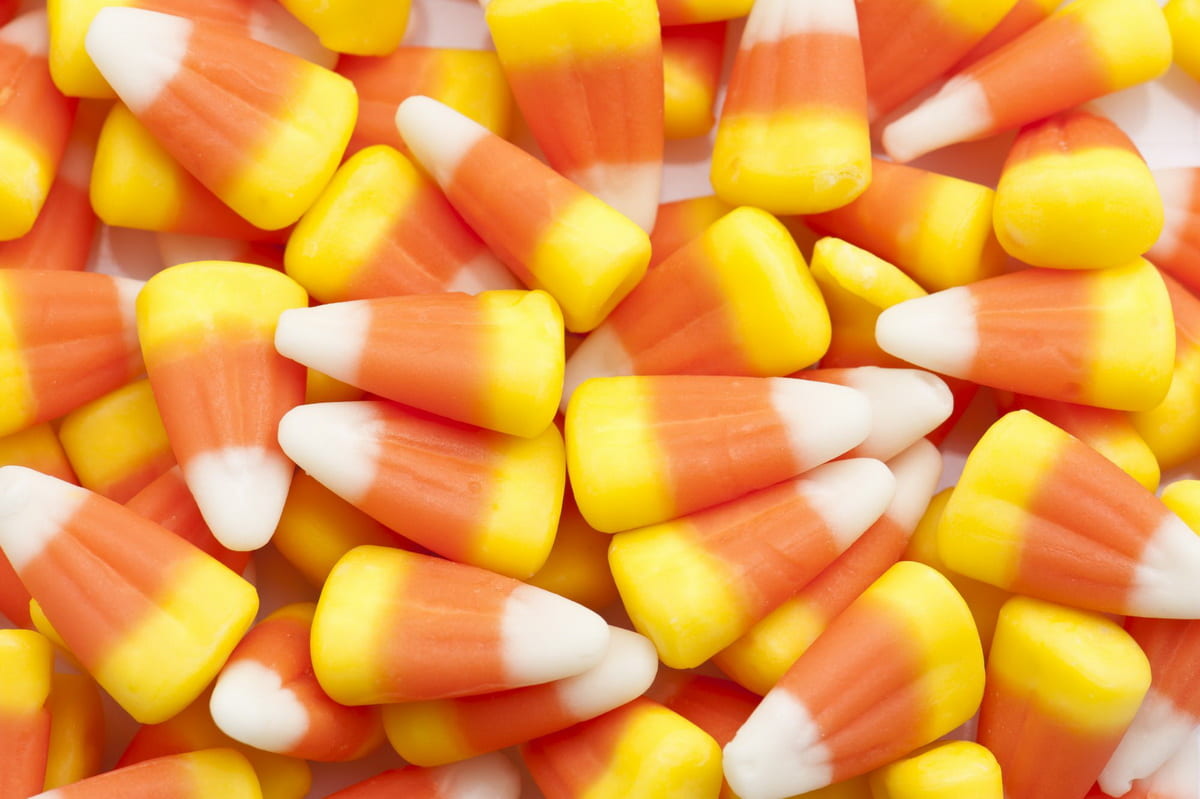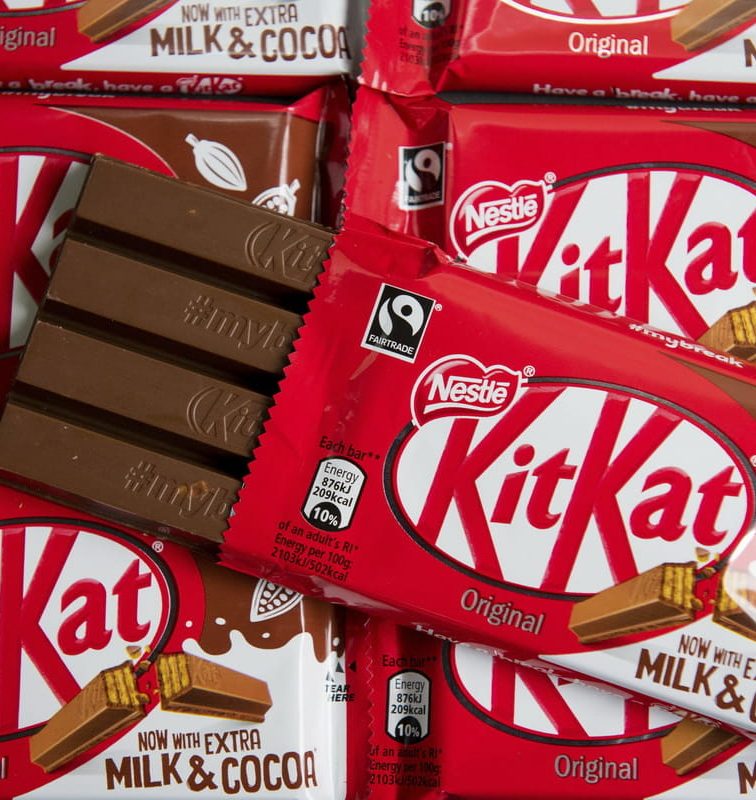When we talk candies, candy corn pops up as a legendary munch! Crafted in the 1880s, this iconic treat has sweetened over 100 years of celebrations. Remarkably, it’s not just a Halloween superstar.
Each year, the U.S. produces a whopping 35 million pounds of candy corn, and that’s no small number. But have you ever paused to wonder about the origin of its quirky name “Chicken Feed”? Or its year-round appeal in the early days? Well, strap in for a tasty history ride through fun facts about candy corn.
1. The Humble Beginnings: Candy Corn’s Debut
Dive deep into the 1880s, and you’ll discover candy corn’s birthplace – the Wunderle Candy Company. It’s where George Renninger visualized a candy resembling the everyday corn kernel. But here’s the catch – candy corn’s size is thrice that of a genuine corn kernel!
The production scene back then was no piece of cake. Workers dedicated hours hand-molding every piece. It was a labor of love, truly. But their dedication bore fruit, gifting us a candy that’s been a favorite for over a century.
2. Not Just for Halloween: Candy Corn’s Year-Round Appeal
Flashback to candy corn’s early marketing strategies, and you’ll find a surprising twist. While today it’s a Halloween staple, it originally catered to a year-round audience. Dubbed “chicken feed” due to its corn-inspired design, its marketing wasn’t solely October-focused.
Advertisements from the yesteryears came with catchy slogans like, “Something worth crowing for!” – clearly targeting a broader audience, including farmers. It’s a sweet reminder that its appeal wasn’t limited to just the ghost and goblins season.
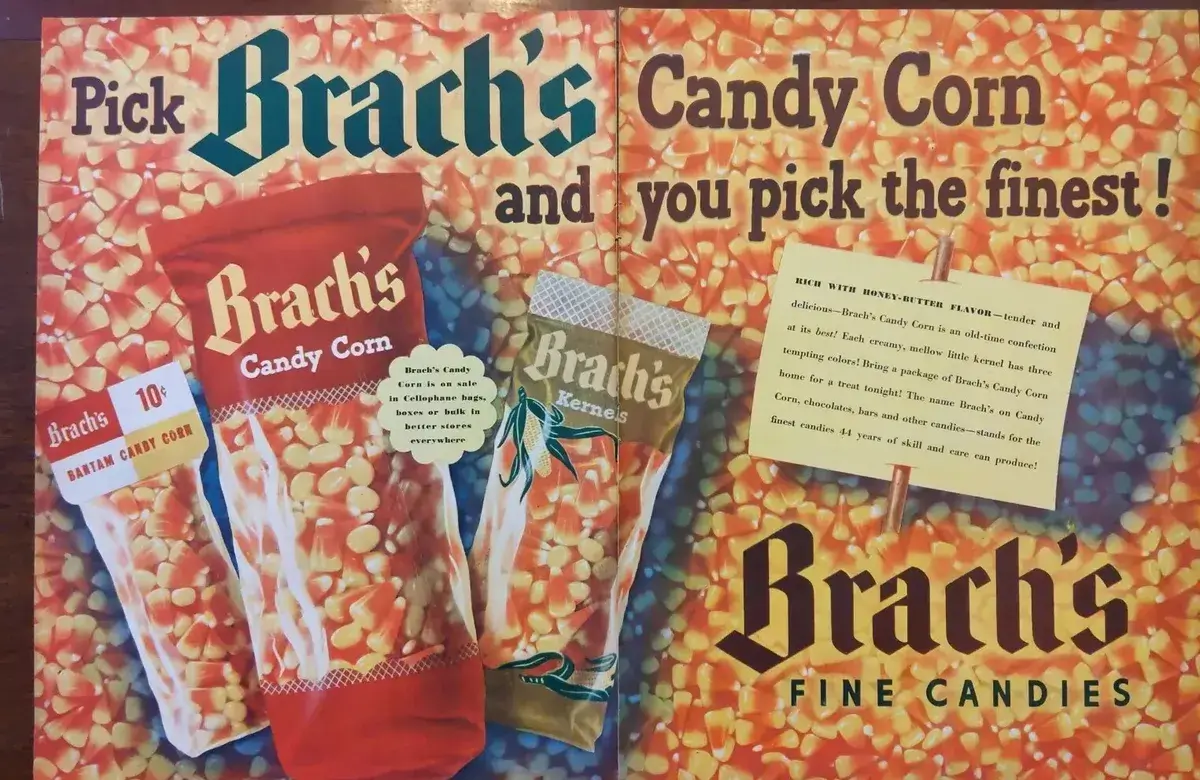
A 1948 classic print advertisement for Brach’s candy. It showcases the original candy corn and spans two pages. Image: deviantart.com
3. Chicken What Now?: The Original Name Game
Dig into the quirky chapters of candy corn’s history, and you’ll unearth its original name – “Chicken Feed.” It might sound odd today, but given its corn kernel inspiration, it made perfect sense back then. Old packaging designs proudly showcased a vibrant rooster, reinforcing the “chicken feed” connection.
However, as decades rolled on, the name transitioned to the now universally recognized “candy corn.” The journey from a barnyard moniker to a Halloween sensation is, without a doubt, a fascinating branding evolution.
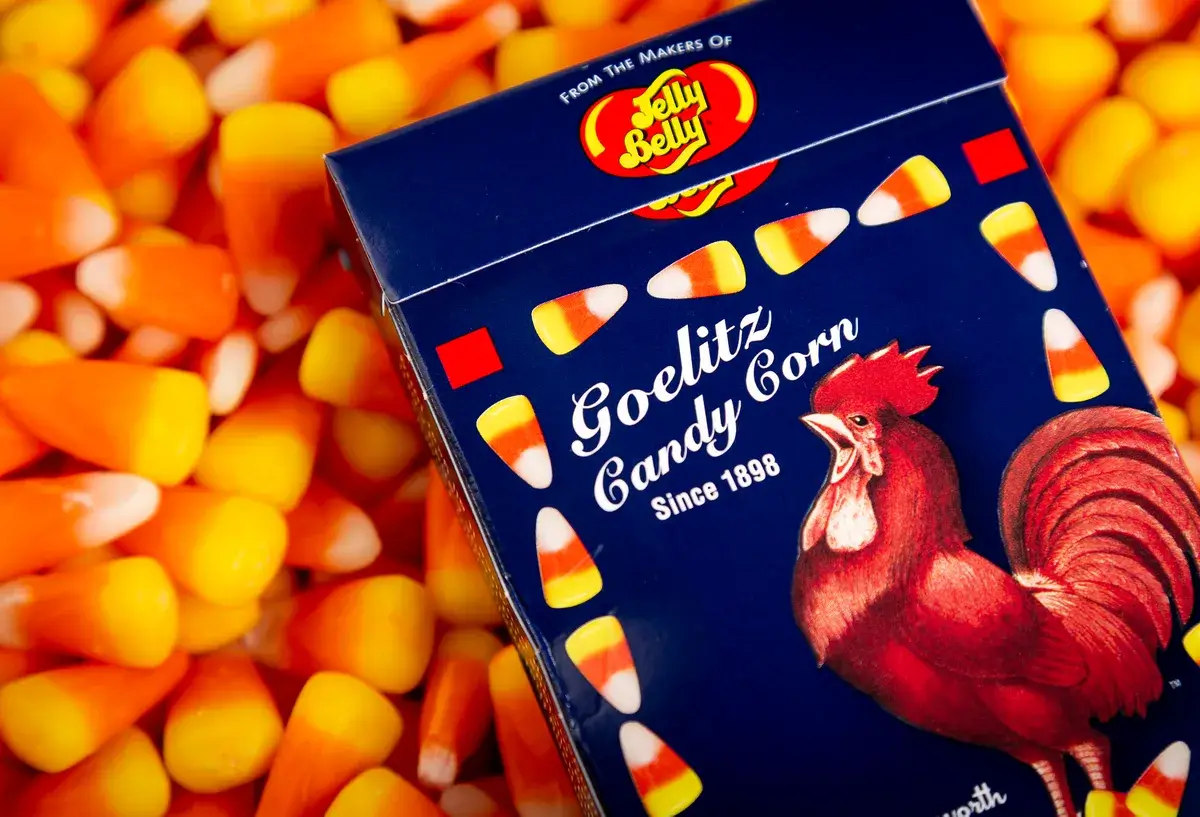
Image: cincinnati.com
4. The Layered Creation Process: How the Colors Stack Up
One of the hallmark features of candy corn is its tricolor scheme. But did you ever wonder how these layers come to life? Well, it’s an art! Starting from the narrow white tip, it progresses to the wider orange center and culminates in a yellow base. Each layer requires its own pour, with workers meticulously ensuring that each color stays distinct.
Interestingly, the production process hasn’t veered much from tradition. The same careful, layered pour that made candy corn unique in the 1900s is still followed, paying homage to its origins.
5. By the Millions: Just How Much Candy Corn Is Produced?
Prepare to be gobsmacked! Every year, over 35 million pounds of candy corn sprinkle sweetness across the U.S. That’s an impressive number for a candy that was once just a niche product in the 19th century. To put it in perspective, imagine the weight of roughly 7,000 average-sized cars – that’s how colossal the production scale is!
Another eyebrow-raising interesting fact: The National Confectioners Association states that if you lined up all the candy corn pieces sold annually, they would circle the moon nearly four times!
6. Old School Production: How Candy Corn Was Originally Made
Back in the day, making candy corn wasn’t about pressing a few buttons on a machine. Instead, it was a manual, labor-intensive process. Workers used to pour the candy mixture into kernel-shaped molds, one color at a time. These molds, often made of cornstarch, helped shape and solidify the candy.
Once set, the candies were extracted, brushed to remove excess starch, and then polished to give them that iconic glossy sheen. It was a time-consuming endeavor, but the result? Worth every second and every painstaking pour!
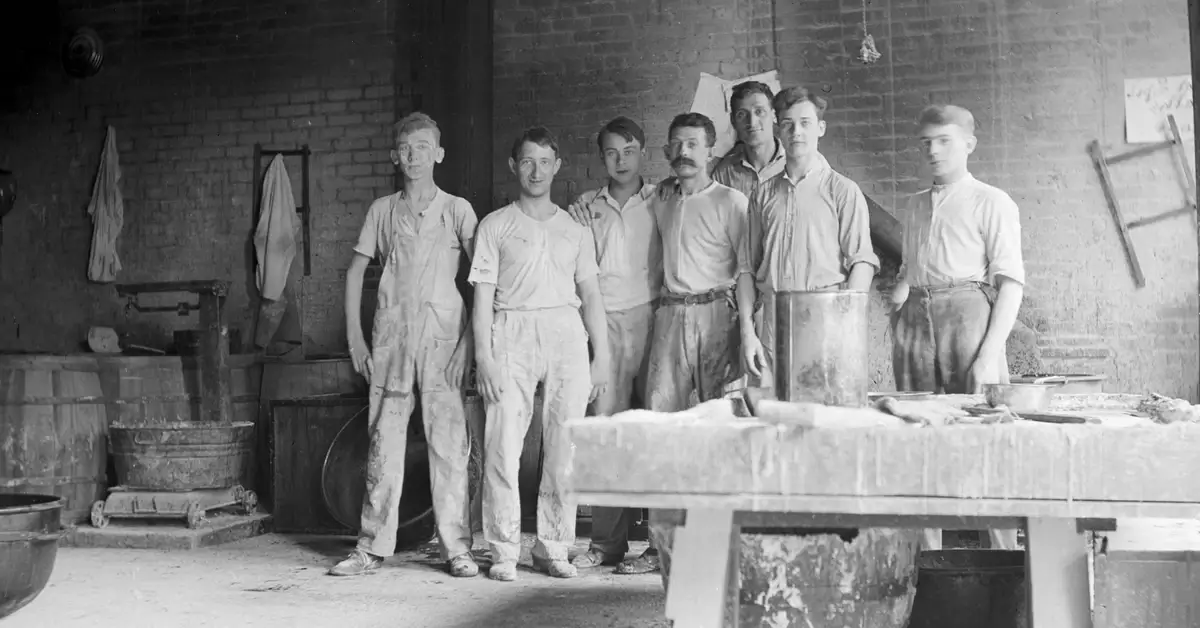
Workers at the Goelitz factory in Cincinnati, the company that kickstarted mass production of candy corn in 1898. Image: cincinnati.com
7. Mouthful of Sweetness: What’s Inside Candy Corn?
Biting into candy corn, you’re met with a burst of sweetness. Ever paused to think about what’s causing that sugary explosion? The primary ingredients are sugar, corn syrup, and marshmallow, lending it that distinct texture and taste. Additional components like confectioners’ wax add to its sheen, while binders maintain its shape.
It’s worth noting that the flavor isn’t just generic sweetness. A hint of vanilla gives it a nuanced taste, making every bite an indulgence. A candy with such simple ingredients creating a symphony of flavors? Now that’s some food magic!
8. Unwavering Recipe: The Original Candy Corn Ingredients
Interestingly, the recipe for candy corn has remained largely unaltered since its inception. Why mess with perfection, right? The early candy makers blended a concoction of sugar, corn syrup, carnauba wax, and water. They would then whip this mixture to get that marshmallowy consistency and add fondant to enhance its smooth texture.
Fun fact: While many candies have seen their recipes evolve with changing times and tastes, candy corn stands firm, a testament to its timeless appeal.
9. Candy Corn’s Odd Cousin: The Easter Variant
While candy corn reigns supreme in Halloween treats, did you know there’s an Easter version? Called “bunny corn,” this variant swaps out the Halloween hues for pastel shades. It often sports colors like pink, green, and purple, aligning with the Easter theme. The taste? It’s strikingly similar to its October counterpart!
This just goes to show that while candy corn is inherently tied to Halloween, its potential doesn’t stop there. It’s versatile enough to hop into other holiday celebrations!
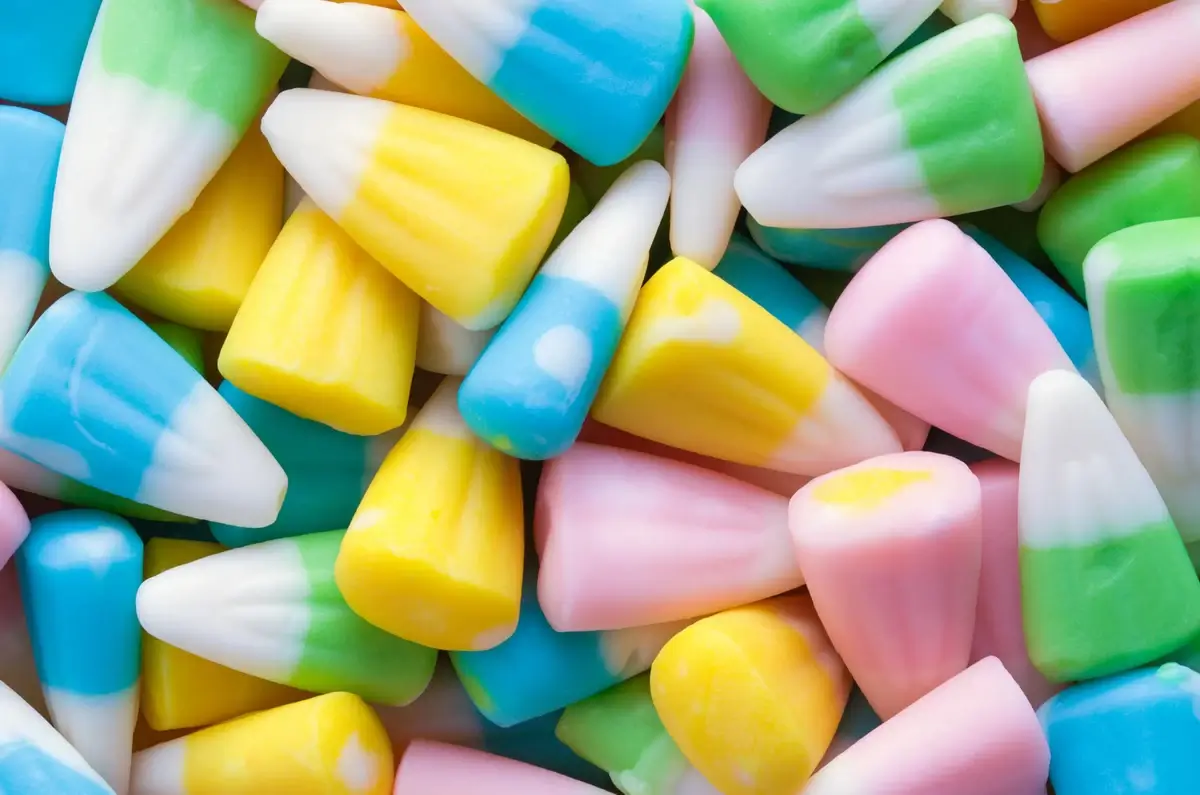
Image: imgix.net
10. Those Signature Colors: Why Yellow, Orange, and White?
Have you ever pondered why candy corn sports yellow, orange, and white layers? Well, it’s designed to mimic an actual corn kernel. The yellow bottom represents the corn’s base, the orange center is the golden middle, and the white tip is the end of the kernel. When you stack them, it even appears like a corn cob!
This interesting fact goes on to show the lengths candy creators went to for authenticity. Ensuring every bite-sized piece genuinely mirrors the look of corn is some dedication!
11. Taste Test: The Love-Hate Relationship with Candy Corn Flavor
While its history and production are intriguing, the flavor of candy corn has long been a polarizing topic. Some folks absolutely adore its sweet, almost honey-like taste, proclaiming it the king of Halloween treats. On the other hand, some find it too sugary or waxy.
Fun fact: According to the National Confectioners Association, candy corn remains one of the most controversial candies in terms of flavor. Yet, its sales and enduring presence suggest it’s still a beloved treat for many.
12. Little Kernels, Big Impact: The Size of Candy Corn
Though they might be small, candy corn kernels pack a punch! Each piece measures roughly three-quarters of an inch in length and a tad over half an inch in width. And while this might seem diminutive, when you consider that billions of these tiny morsels are consumed each year, their collective impact is gigantic!
Fun fact: Despite their small stature, it would take about 1,200 pieces of candy corn to weigh a pound. That’s a lot of kernels for your candy dish!
13. Candy Corn Across the Pond: How Other Countries See It
While candy corn is a staple during the Halloween season in the U.S., its presence internationally is a bit more muted. In many countries, candy corn is either unheard of or seen as a quirky American treat. For instance, in the UK and parts of Europe, while Halloween is celebrated, candy corn hasn’t quite made the iconic mark it has in the U.S.
However, with globalization and pop culture, the tri-colored candy is gradually finding its way to foreign candy aisles. It’s a sweet testament to how foods can traverse borders!
14. Economic Sweetspot: Candy Corn’s Boom in the Great Depression
The 1930s was a trying time for America, with the Great Depression gripping the nation. Yet, amid this economic turmoil, candy corn stood as a beacon of hope. With its affordable pricing, it became a staple treat, providing a sweet respite in harsh times.
Historical records show that candy corn sales saw an unexpected surge during these years. It was a candy that even cash-strapped families could afford, costing just pennies for a handful. This affordability, coupled with its delightful taste, made candy corn the go-to treat, offering a glimmer of happiness in an otherwise gloomy period.
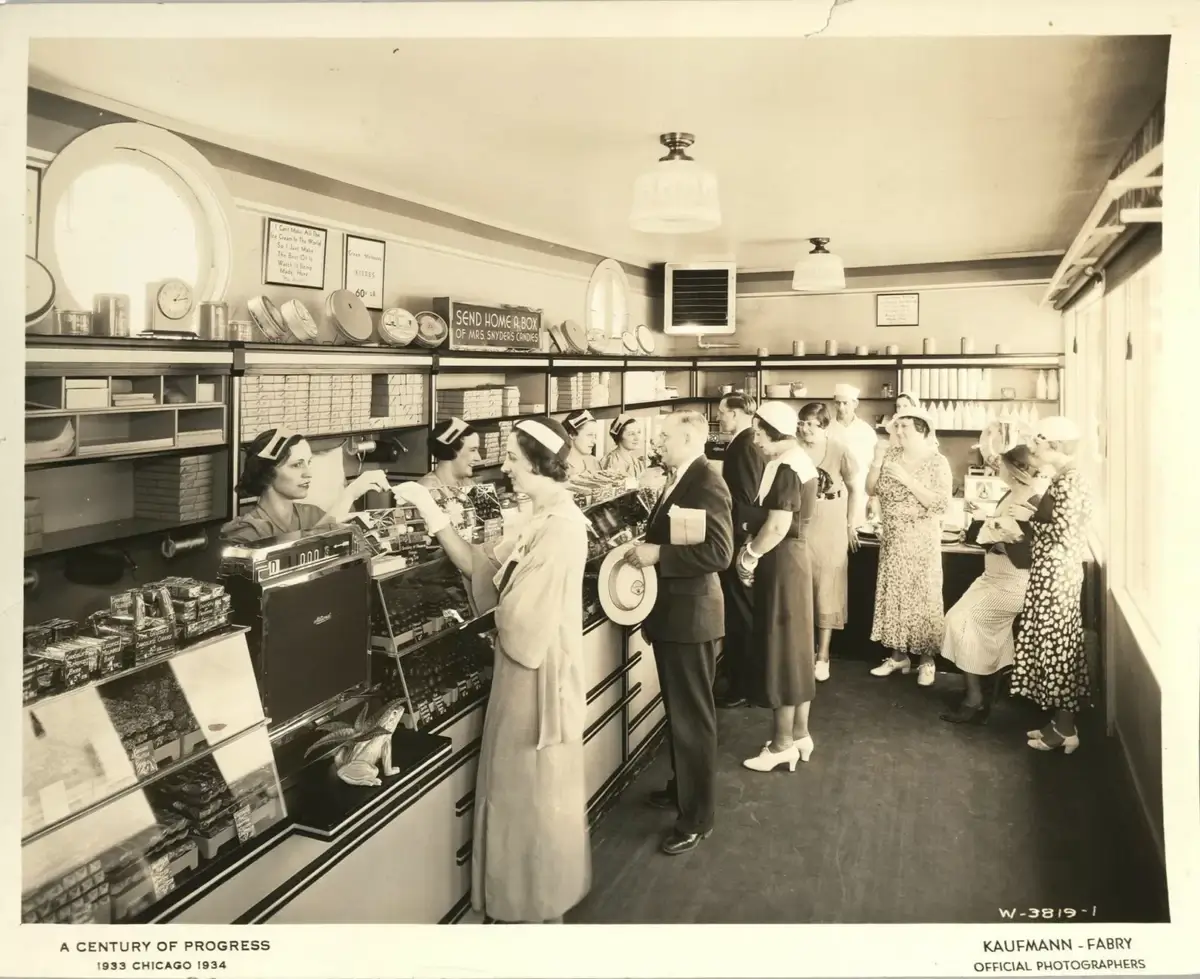
Image: newberry.org
15. Brands that Boomed: Leading Candy Corn Producers
Candy corn has seen various producers over the years, but a few brands stand out for their consistent quality and taste. Brach’s, for instance, is one such heavyweight. Founded in 1904, Brach’s has cemented its place as a candy corn titan, offering a taste that many consider the gold standard.
Another significant player? Jelly Belly! Though they’re more renowned for their gourmet jelly beans, their candy corn production is top-notch. It’s fascinating how different companies have kept the essence of candy corn while adding their unique touches.
16. Sugar High: Candy Corn’s Nutritional Breakdown
Given its sugary sweetness, one might wonder about the nutritional makeup of candy corn. Surprisingly, while high in sugar (about 28 grams in a 19-piece serving), it’s fat-free! But that doesn’t exactly make it a health food. Each serving also delivers around 140 calories. It’s a treat, after all.
Still, for those looking for a bite-sized sugar rush, especially around Halloween, candy corn remains a go-to. Moderation is key, and as with all things sweet, it’s best enjoyed in balance.
17. A Sweet Celebration: National Candy Corn Day
Believe it or not, this candy has its own day of celebration! National Candy Corn Day is celebrated every October 30th, right before Halloween. The day celebrates the history, taste, and cultural impact of this confection.
While it’s unclear how this day originated, it’s undoubtedly a favorite for candy corn lovers. It’s a day to indulge, reminisce, and share the joy of this beloved candy.
18. Confectionery Endorsement: The National Confectioners Association’s Take
The National Confectioners Association recognizes candy corn as a nostalgic and iconic candy, especially during Halloween. According to their data, a staggering 9 billion pieces of candy corn are produced annually. That’s nearly 35 million pounds!
Their endorsement is not just about numbers. The association lauds the candy for its rich history, distinct flavor, and ability to evoke memories from Halloweens past. It’s sweet to see such a powerful confectionery body celebrating this tiny candy’s vast impact.
19. Candy Corn Couture: Fashion Inspired by Candy Corn
Move over, runways of Paris and Milan! Candy corn has made its splash in the fashion world. From candy corn-patterned socks, hats, and sweaters to more avant-garde pieces like evening gowns, the iconic tri-color design has inspired many fashionistas.
It’s not just clothing either; nail art, jewelry, and even hairstyles have seen the candy corn influence. This goes to show that candy corn isn’t just a treat for the taste buds but also a treat for the eyes!
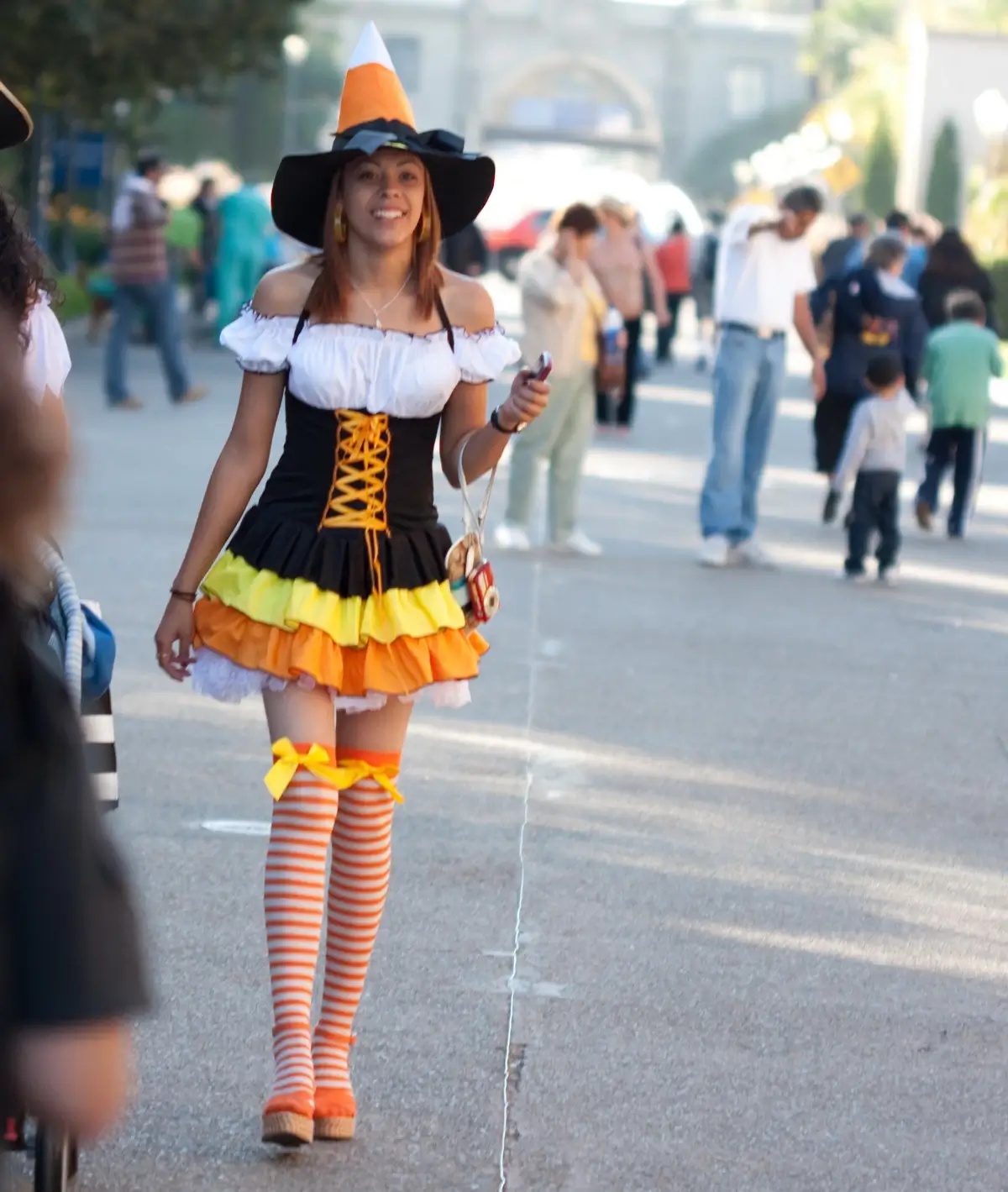
Nathan Rupert / Flickr
20. The Perfect Bite: Best Ways to Enjoy Candy Corn
Candy corn isn’t just a grab-and-go candy; aficionados have devised some creative ways to savor it. Some swear by the method of biting each color separately, starting with the white tip, then the orange middle, and finally the yellow base. Others love mixing candy corn with salty peanuts, creating a delightful sweet and salty combo.
And then, there are those who melt it into a creamy fondue or sprinkle it atop frosted cupcakes. No matter how you choose to indulge, each bite is sure to be a burst of sweet nostalgia.
21. Candy Corn Crafts: Artistic Takes on the Treat
The vibrant colors of candy corn aren’t just for eating—they serve as inspiration for crafty minds too! DIY enthusiasts create wreaths, painted jars, and even candles shaped and colored like our beloved candy. During Halloween, candy corn crafts can be spotted adorning houses, giving a sweet touch to spooky decorations.
These crafts aren’t just for show; they’re often family projects that become treasured memories. Candy corn, thus, stitches together not just fabrics or materials but also hearts.
22. Beyond the Basic: Flavor Variations Over the Years
While the classic candy corn flavor has remained largely unchanged, candy producers have dabbled in various flavor experiments over the years. From chocolate to caramel apple, and even tropical fruit, there have been numerous twists to the traditional recipe. Some of these flavors have found a loyal fanbase, while others were fleeting seasonal editions.
The versatility of candy corn ensures that there’s always something new to tantalize taste buds, proving that innovation in candy is as limitless as imagination.

Image: myhalfassedkitchen.com
23. Candy Corn’s Impact on Economy: How Much Do People Spend?
This might seem like a fun treat, but when it comes to economics, candy corn is no small player. The National Confectioners Association reports that during the Halloween season alone, over $30 million is spent on candy corn! Given its seasonal nature, this candy sees a sales spike unlike many other confections.
Many local candy shops and large-scale producers rely on this seasonal boom, making candy corn a significant player in the confectionery industry’s annual revenues.
24. In Pop Culture: Candy Corn’s Cameos in Movies and TV
Did you know that candy corn has brushed shoulders with Hollywood stars? This iconic candy has made its mark on the entertainment industry. In the popular TV series “Friends,” Ross is teased about his teeth looking like candy corn. In “The Simpsons,” there’s a scene in which Bart swaps out his tooth for candy corn to trick the tooth fairy. And let’s not forget its numerous appearances in Halloween-themed episodes across various shows.
Candy corn even had a dedicated scene in the movie “Halloween II,” where a child is shown biting into an apple, only to find a razor blade amid candy corn pieces. It’s fascinating how this tiny candy has found its way into memorable cinematic moments, symbolizing the essence of Halloween.
25. The Candy Corn Legacy: How It Became a Halloween Staple
When you think Halloween, candy corn isn’t far behind in thought. But how did this candy become synonymous with the spooky holiday? Its inception in the late 1800s by the Wunderlee Candy Company, originally as “chicken feed”, was timely. Its colors, resembling the harvest season, naturally made it a fall favorite. By the time Halloween evolved into the candy-centric holiday it is today, candy corn was perfectly positioned to become its sweet mascot.
The tradition of “trick-or-treating” post-WWII further solidified candy corn’s Halloween status, making it a treat bag essential for decades to come.
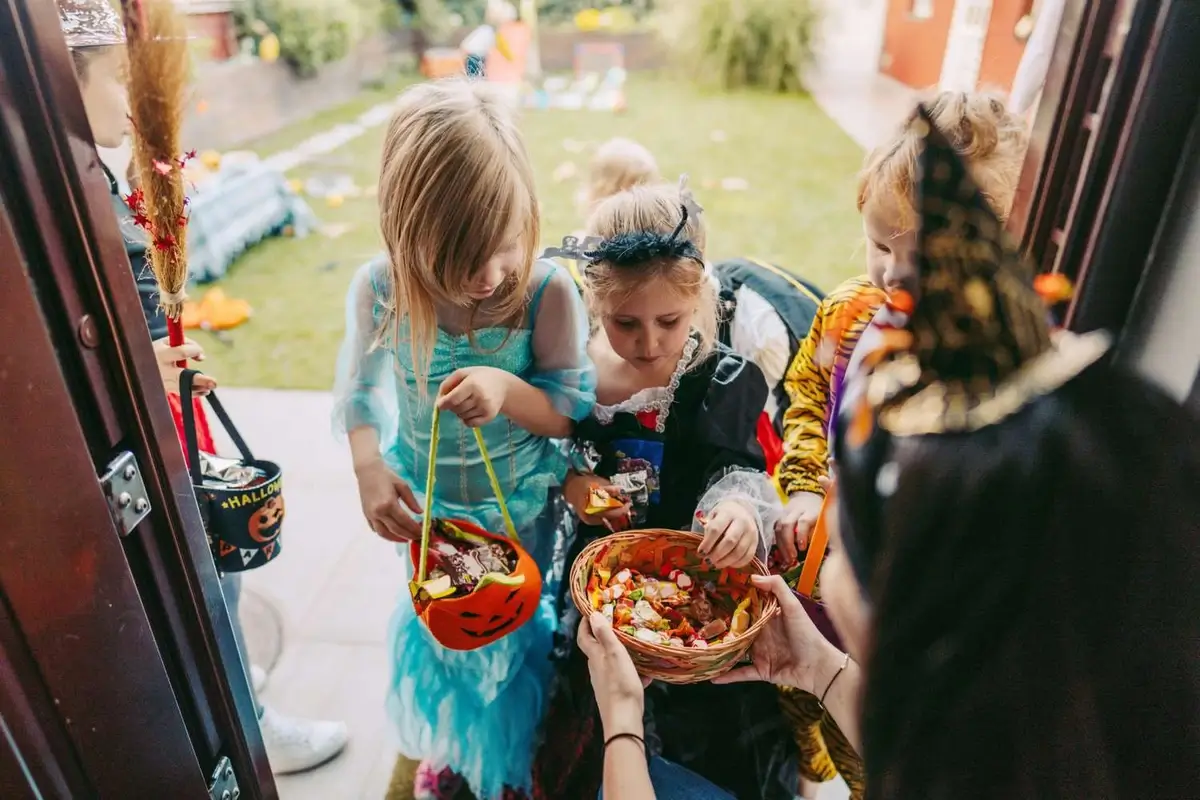
Image: marthastewart.com
FAQ
Why is it named candy corn?
Candy corn’s name is a simple nod to its appearance. When you look at a kernel of this candy, it resembles a whole kernel of corn, especially when they’re stacked together. Though each individual piece looks more like a corn kernel that’s been sliced off the cob, when aligned in a circle with the broad yellow end in the center, it creates an illusion similar to an actual corn cob.
What are the 3 flavors of candy corn?
Contrary to popular belief, the three colors of traditional candy corn – white, orange, and yellow – are not different flavors. The entire candy is a single flavor, often described as a mix of creamy, vanilla sweetness. However, over time, various brands have introduced different flavors, but the classic candy corn remains uniformly flavored.
What is candy corn really called?
Originally, candy corn was called “Chicken Feed.” This name harks back to the late 1800s and early 1900s, emphasizing its agricultural theme. The Goelitz Confectionery Company, now known as the Jelly Belly Candy Company, was one of the earliest producers and labeled it as “butter sweet candy.”
What does candy corn stand for?
Candy corn has become a symbol of Halloween and fall in the United States. Over the years, it has come to stand for the nostalgia of old-fashioned Halloween celebrations, childhood memories, and the harvest season. The candy’s tricolor design also mirrors the colors of autumn leaves.
Are candy corn healthy?
Like most candies, candy corn is high in sugar and calories and should be consumed in moderation. It doesn’t offer any essential nutrients, vitamins, or minerals. One serving can contain around 28 grams of sugar. While it’s okay to enjoy them occasionally, they shouldn’t be considered a health food.
Who made candy corn popular?
The Goelitz Confectionery Company, known today as the Jelly Belly Candy Company, played a significant role in popularizing candy corn. They began producing the candy in the late 1800s, and their commitment to the traditional recipe and method of production helped establish candy corn as a popular treat, especially around Halloween.
Why is candy corn iconic?
Candy corn’s iconic status can be attributed to its unique appearance, long-standing history, and association with Halloween and harvest celebrations. It’s one of the few candies that have remained relatively unchanged in both design and flavor for over a century, becoming synonymous with fall festivities.
What did candy corn taste like?
The classic candy corn flavor is a blend of sugar, corn syrup, and marshmallow. Its taste is often described as sweet, creamy, and somewhat vanilla-like. While the recipe has remained mostly consistent over the years, some variations and brands may have subtle differences in flavor.
Why is candy corn only for Halloween?
While candy corn is available year-round in some places, its surge in popularity during Halloween can be linked to its fall colors and harvest-themed design. Its association with the season has been cemented over the decades. However, there are variations of candy corn, like the “Reindeer Corn” for Christmas or “Bunny Corn” for Easter.
How many candy corns are made in a year?
It’s estimated that over 35 million pounds of candy corn are produced each year. To put that in perspective, that’s nearly 9 billion pieces of candy! This impressive number showcases just how beloved this tri-colored confection is, especially around the Halloween season.


